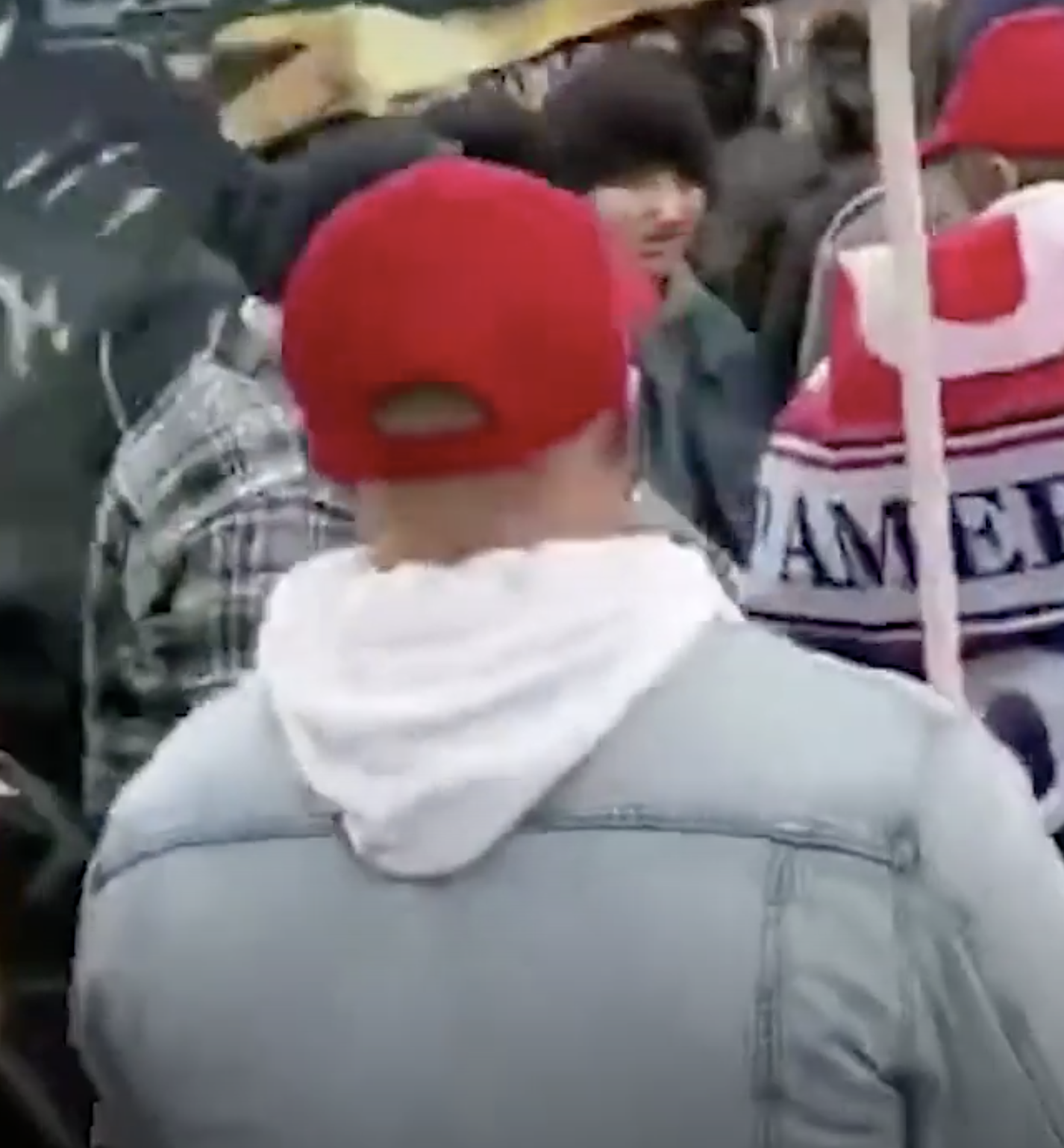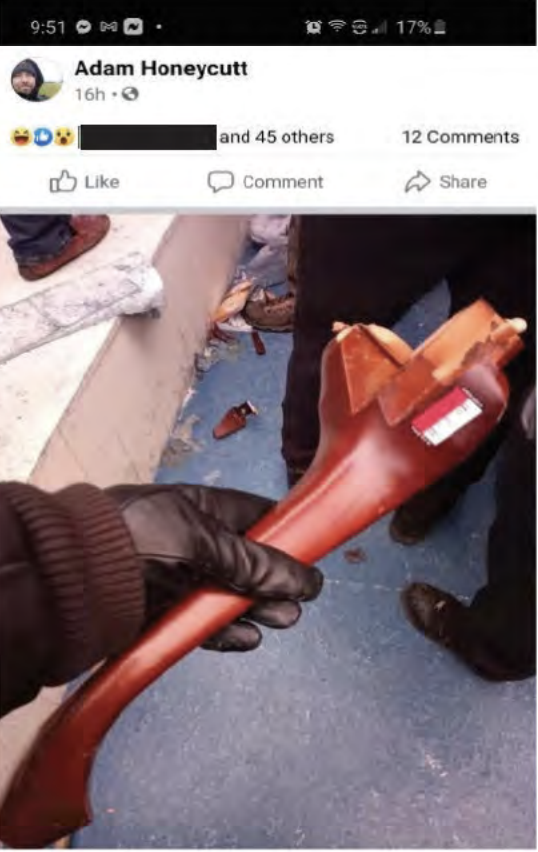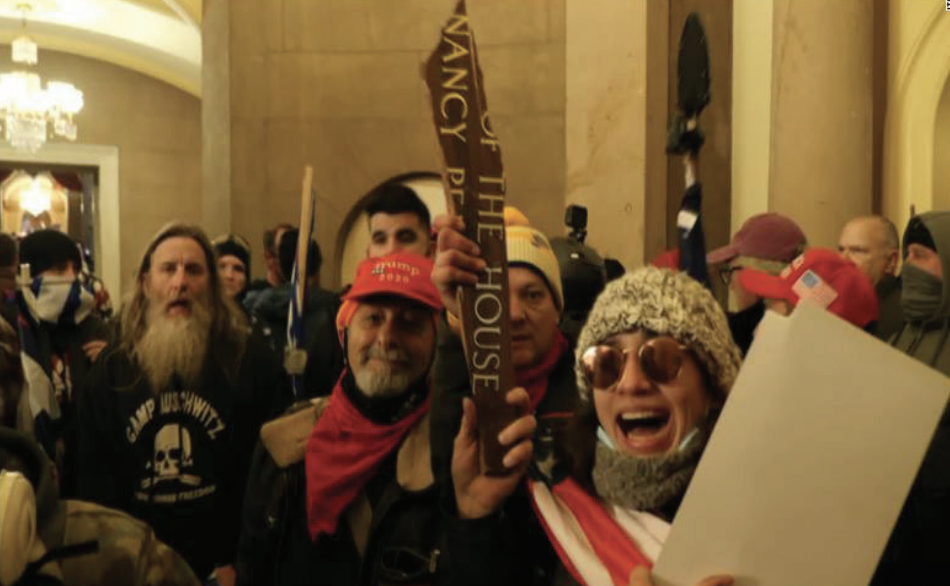Puzzling Developments in the January 6 Investigation
As I sometimes do, I’d like to look at some curious developments in a series of January 6 cases.
Adam Honeycutt’s trips to DC
If you read just his arrest affidavit, former bail bondsman Adam Honeycutt is a guy who made the grave mistake of posting a picture of himself holding a broken furniture leg to Facebook during the January 6 riot.
Honeycutt was arrested on misdemeanor trespass charges on February 11, but since then his DC case has been continued, with no indictment, until — with the most recent continuation at a status hearing on Tuesday — January 4, almost a year after the riot.
If you look more closely, however, things get more confusing. As several earlier requests for continuances reveal, Honeycutt made the still graver mistake of having guns and non-legal marijuana in his home when the FBI came to arrest him on his January 6 charges, and then chatting about it as he was being driven to the FBI office.
During the transport, HONEYCUTT made a number of unsolicited statements to TFO Rohermel and SA Grover related to his use of marihuana. HONEYCUTT stated that all of the drugs and guns in the house belonged to him, that he knew it looked bad ot have guns layout out in the open in his residence, that he had a large quantity of ammunition of various calibers in the residence, some of which was for firearms he did not currently possess. HONEYCUTT also stated that it was lucky that agents had executed the warrants that day, because his marihuana supply was almost gone, and if the agents had executed the warrants the following day he would have had more because Fridays are his day for resupplying marihuana. HONEYCUTT stated that there were only a few “roaches” left in the garage, referring to burned marihuana cigarette butts. HONEYCUTT stated that he had been smoking marihuana since he was twelve years old and smokes daily. HONEYCUTT expressed to the agents that he was upset he was out of marihuana and there would not be any for him when he got home.
Honeycutt was as a result also charged under a bullshit draconian war on drugs law that carries a ten year maximum sentence, meaning what otherwise might have been a simple trespassing plea turned into (thus far) 8 months of detention on the Florida Federal charge. Honeycutt pled guilty to that charge in June, but is still awaiting sentencing, which is scheduled for next week.
And there’s a curious detail in his sentencing memo on that charge. He reveals that somewhere along the line, he got transferred to DC, even though by March he was formally released from custody on the DC charge.
Mr. Honeycutt has been in custody continuously since February 24, 2021 and has had the additional hardship of prolonged transports from McClenny to Washington, DC in during the pandemic. While in transit, Mr. Honeycutt was assaulted by another inmate while using the phone at the Grady County Jail in Oklahoma. The inmate struck him on the back of the head causing Mr. Honeycutt to hit his head on the ground and suffer dizziness and a black eye. While he suspected he may have had a concussion, this has never been confirmed medically. Also, while detained at the Baker County Jail, Mr. Honeycutt tested positive for Covid-19 and was placed on restrictive quarantine for 14 days while he recovered.
None of that shows up in his docket, though it may simply reflect a remarkably quick transfer after his initial arrest (and Honeycutt would not be the only January 6 defendant who got in a beat up at the Oklahoma transfer jail).
I don’t condone any of this, least of all the war on drugs treatment of marijuana possession. But it’s the kind of stuff that prosecutors use to coerce cooperation elsewhere. And while it’s not at all clear what went on with Honeycutt, his case will still be pending next year on the anniversary of the riot.
Lonnie Coffman’s Alabama Molotovs
Something similar may be going on with Lonnie Coffman’s Molotov cocktails.
Coffman, you’ll recall, is the guy who was dropped off blocks away from the Capitol on January 6, trying to pick up his GMC pick-up full of Molotov cocktails.
After addressing the explosive devices found in the vicinity of the National Republican Club and the Democratic National Committee Headquarters, the Bomb Squad responded to the location of the Red GMC Sierra Pickup truck. One black handgun was recovered from the right front passenger seat of the vehicle. After locating the black handgun, officers proceeded to search the rest of the pickup truck, including the bed of the truck, which was secured under a fabric top. During the search of the cab of the truck, officers recovered, among other things, one M4 Carbine assault rifle along with rifle magazines loaded with ammunition.
In addition, officers recovered the following items in the bed of the pickup truck in close proximity to one another: (i) eleven mason jars containing an unknown liquid with a golf tee in the top of each jar, (ii) cloth rags, and (iii) lighters. Upon finding these materials, bomb technicians observed that the items appeared to be consistent with components for an explosive or incendiary device known as a “Molotov Cocktail.” Based on this discovery, additional personnel were called to the scene, including the United States Capitol Police Hazardous Materials Team. A preliminary test by the United States Capitol Police Hazardous Material Team determined that the liquid in the mason jars was an igniting substance and that it had a spectrograph profile consistent with gasoline.
[snip]
At approximately 6:30 p.m., a blue sedan with a female driver and a male front passenger, approached law enforcement officers in the 400 block of First Street, Southeast. Officers made contact with the vehicle, and the male passenger stated that he was trying to get to his vehicle that was parked in the 300 block of First Street, Southeast, which is the location that the Red GMC Sierra 1500 pickup truck had been located and searched. When the officers asked the man to provide a description of the vehicle, the male passenger stated that it was a red pickup truck. The officers then asked what the male passenger’s name was, and he stated that his name was “Lonnie.”
Coffman also has been detained (more justifiably than Honeycutt) since he was arrested. For much of that time, he has been working on a plea agreement, and on September 1, his lawyer reported they were close to one. On September 8, AUSA Michael Friedman said they would be ready for a plea by September 29.
But one day before that happened, the plea hearing was inexplicably vacated until October 26.
Unnoticed until yesterday, it turns out that on September 27 (that is, the day before his plea hearing was vacated), Coffman was charged in Alabama for possessing those Molotov cocktails the week before he drove them to DC. With Coffman’s consent, that case got transferred to DC in an entirely different docket than his January 6 one.
As with Honeycutt, it’s entirely unclear how his Alabama Federal charges are intersecting with his DC ones. Perhaps Coffman got cold feet on his plea last month, so DOJ added the Alabama charges to convince him to plead. But its another reminder that not every part of the January 6 investigation will be visible in the DC docket.
Brandon Straka gets to walk away
Meanwhile, a case that never left the DC docket, that of Brandon Straka, is just as curious.
Straka was first arrested on January 25 on civil disorder, as well as trespass, charges. Since that time, AUSA April Russo has gotten a series of continuances (February, May, August), each one citing efforts to resolve the matter, which is usually code for a plea agreement. A week after the last continuance, DOJ made a plea offer that had to be accepted by September 14. The day after the plea agreement would have expired, Straka was ultimately charged with the less serious of the two trespass charges, and after a tweak, that’s what he pled guilty to on Wednesday.
Straka’s Statement of Offense includes (and Russo made a point of entering it into the record) the incitement of attacks on cops that originally got him charged for civil disorder.
While in the restricted area, knowing he was not authorized to be there, Straka observed the crowd yelling and U.S. Capitol Police trying to prevent people from going into the U.S. Capitol and to manage the unruly crowd. Amongst other things, he engaged in disruptive conduct by participating, along with others, in yelling “go, go, go” to encourage others to enter the U.S. Capitol while the U.S. Capitol Police were making their best efforts to prevent people from doing so. Straka also observed others yelling to take a U.S. Capitol Police Officer’s shield. He recorded a video of what was happening, and in the video, he chimed in with the crowd, saying “take it, take it.” He did this between 2:30 and 2:45 p.m. on January 6 while outside the entrance to the U.S. Capitol in the restricted area on the Capitol Grounds. Straka left the U.S. Capitol Grounds at approximately 3:00 p.m.
But the Statement of Offense doesn’t include any description of his speech from January 5, where he spoke about “revolution.”
My review of STRAKA’s Twitter account on January 11, also found a video he had posted of himself speaking at a “Stop the Steal” rally held at Freedom Plaza in Washington, D.C. on January 5, 2021. As of January 13, STRAKA had removed this video from his Twitter account, but a video of the entire event had been posted to YouTube. The video showed that STRAKA was introduced by name and brought onto stage. STRAKA spoke for about five minutes during which time he repeatedly referred to the attendees as “Patriots” and referenced the “revolution” multiple times. STRAKA told the attendees to “fight back” and ended by saying, “We are sending a message to the Democrats, we are not going away, you’ve got a problem!”
Nor does his Statement of Offense include this language from Straka’s arrest affidavit describing a video in which he admitted that, “The plan was always to go to the Capitol.”
About one minute into the video, STRAKA stated, “I literally just got home…minutes ago from Washington, D.C.” Later in the video, STRAKA stated, “Yesterday, a lot of us got up very, very early. We went to this event in which Donald Trump spoke. The plan was always to go to the Capitol. We were going to march from that event…to the Capitol, and there was going to be another rally. I was one of the speakers slated to speak at the Capitol.” STRAKA later stated that, while riding the metro to the Capitol, he received alerts on his phone stating that Vice President Pence was “not going to object to certifying Joe Biden.” STRAKA stated that he learned on his walk from the metro to the Capitol that people had “breached” the Capitol and that “patriots had entered the Capitol.” STRAKA said that he thought to himself, “Wow, so they’re going to basically storm and try to get into the chamber so that they can demand that we get the investigation that we want.”
Not only was Straka permitted to a plea that may help him avoid all jail time, but DOJ assented to letting him rush the sentencing so he could be done by Christmas, coincidentally on the same day all the status reports for Oath Keeper cooperators are next due.
Baked Alaska — someone as wired into the organizers of this riot as Straka — claimed early on that prosecutors were threatening to charge him with obstruction if he didn’t cooperate.
This plea looks like it could be the flip (heh) side of such an offer, someone who worked his way out of an existing felony charge and any further exposure on obstruction. That said, his plea includes the standard boilerplate language about minimal cooperation (basically, requiring the defendant share the contents of his phone).
If this does reflect cooperation, then it suggests a number of other people exposed to felony prosecution may similarly be cooperating under the guise of misdemeanor plea agreements.
Ryan Samsel’s aborted cooperation
For about the first four months after Ryan Samsel kicked off the entire riot on January 6 by allegedly knocking over a cop, it looked like he might be considering a cooperation agreement. The same prosecutor who filed continuances in Straka’s case, April Russo, was filing continuances in his case (March, May), also citing efforts to resolve the case.
But on March 21, Samsel was brutally assaulted in jail; his attorney claimed at the time that a guard did it, though that has never been officially confirmed. Samsel’s assault set off a feeding frenzy as one after another attorney — first Martin Tankleff, then John Pierce (whose clients include a significant bunch who could incriminate Joe Biggs), and now Stanley Woodward and former Trump vote fraudster Juli Haller — tried to capitalize off a client who might have basis for a big lawsuit against DOJ (Elisabeth Pasqualini did very competent work as Samsel’s first attorney before all this started). The events that transpired after that assault seems to have ended up changing prosecutors’ approach with his case, and in June, DOJ added another prosecutor, Danielle Rosborough, and in August, DOJ finally indicted Samsel on two counts of civil disorder, two counts of assault, obstruction, and trespassing. (Russo remains the sole prosecutor on the case against the woman who was (and may still be) Samsel’s girlfriend on the day of the riot, Raechel Genco.)
All that’s important background to a big scoop from NYT’s Alan Feuer, describing that, when Samsel was originally arrested, he told the FBI that he kicked off that assault after a threat from Joe Biggs.
For months, however, according to three people familiar with the matter, the government has known Mr. Samsel’s account of the exchange: He has told investigators that Mr. Biggs encouraged him to push at the barricades and that when he hesitated, the Proud Boys leader flashed a gun, questioned his manhood and repeated his demand to move upfront and challenge the police.
Mr. Samsel’s version of events was provided to the government in late January, when he was interviewed by the F.B.I., without a lawyer present, shortly after his arrest in Pennsylvania, according to the people familiar with the matter. He has since been charged with several crimes, including assaulting an officer and obstructing Congress’s efforts to certify the election results.
[snip]
[I]f Mr. Samsel’s account is true, it could serve to bolster arguments that some Proud Boys leaders intentionally incited ordinary people in the crowd — or what they refer to as “normies” — to commit violence during the attack. The government has offered other evidence, drawn from the group’s internal messaging chats, that two Proud Boys leaders from Philadelphia were excited by the prospect of “riling up the normies” on Jan. 6.
As Feuer notes, Biggs’ lawyer Daniel Hull categorically denies this claim. As he also notes, there has been no hint of a weapons charge against Biggs. So it’s quite possible that this allegation was entirely made up out of thin air–or exaggerated in a bid for lenient treatment for Samsel’s own central role in the riot.
But there’s also no sign that DOJ is charging Samsel with lying about these claims.
That is, from the public filings, we can’t discern whether Samsel’s allegation is true or not.
That said, if it’s true, it might explain both the apparent attempt to woo Samsel’s cooperation, but also the urgency surrounding efforts to make sure he doesn’t do so.
The government has flamboyantly obtained cooperation from five different Oath Keepers. But precisely what the government is doing in a slew of other cases remains obscure.
Update: There were three people involved in the assault on the first barricade: Samsel, Paul Johnson, and Stephen Chase Randolph. The latter two are charged together, though Johnson is moving to sever his case from Randolph’s. Here’s the government opposition. Never addressed in it are why Samsel is not only not charged with them, but is before an entirely different judge, who just happens to be the Proud Boy judge.



